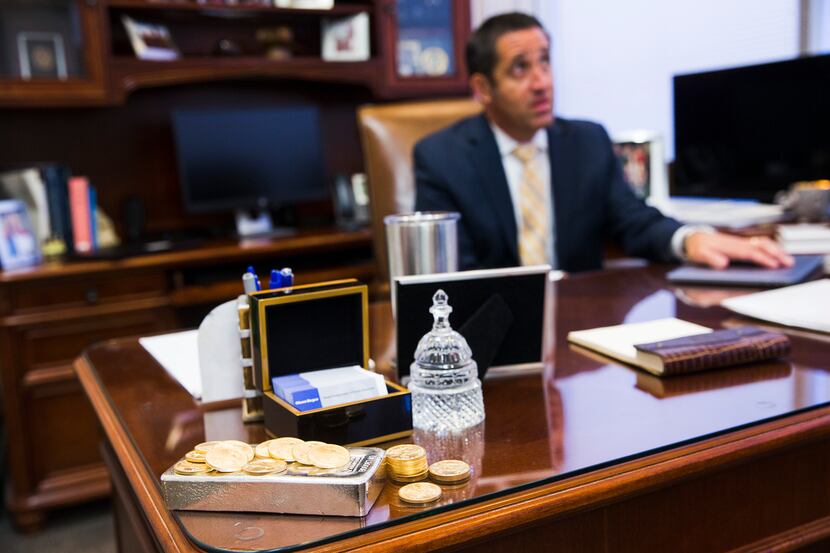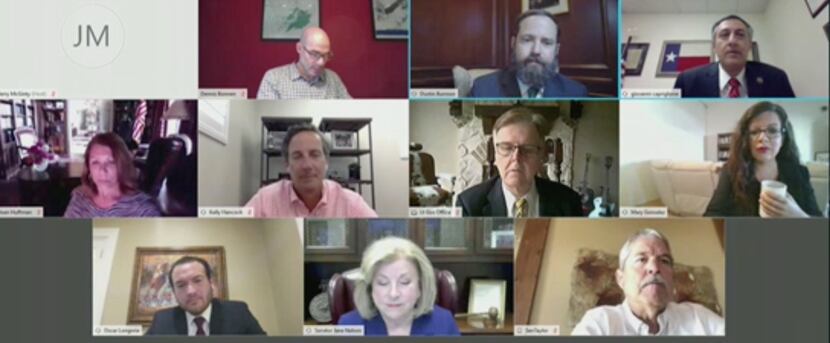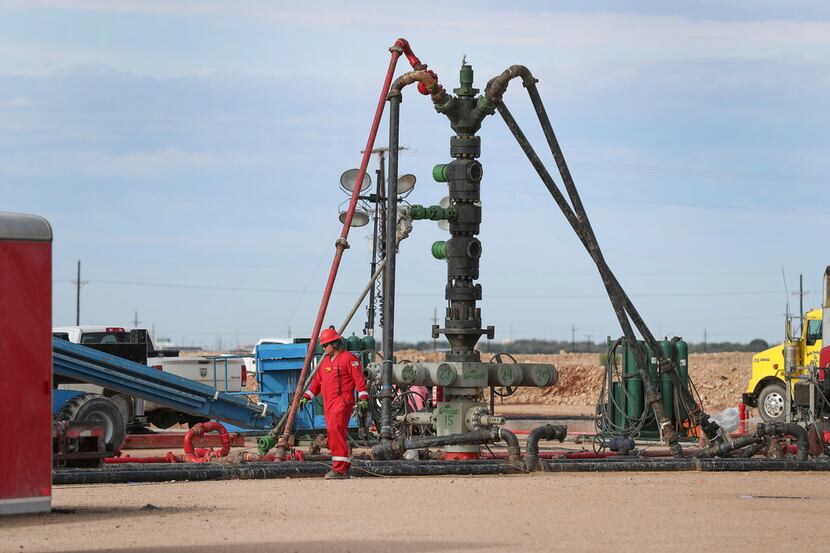Updated at 1:15 p.m.: to include key lawmakers’ discussion of Texas’ economic prospects.
AUSTIN — Comptroller Glenn Hegar on Monday said an economic slowdown caused by the coronavirus and an oil slump are erasing a $2.9 billion surplus expected for the state’s current two-year budget cycle, producing instead a $4.6 billion revenue shortfall.
“It’s such a big number; there’s a pretty big gap there,” Hegar said of his revised estimate that there will be just $110.19 billion of general-purpose state revenue.
In October, he’d predicted Texas would take in $121.76 billion of such discretionary state dollars in the cycle that ends in August 2021. It usually takes a number of months for an economic recession to inflict major pain on state finances, Hegar noted.
Not this year, he told legislative leaders.
“Economic forecasts in the second quarter moved from projections of modest growth to modest decline and then to record-breaking contraction — all in a matter of weeks earlier this spring,” he said.
The shortfall would’ve been worse had it not been for developments such as federal coronavirus aid and higher property values that slightly eased the state’s obligation to pay for schools, as well as strong sales tax collections on e-commerce, Hegar added.
His revised forecast came as key lawmakers had their first public discussion since the COVID-19 outbreak began of the economic carnage the virus has caused — and what challenges they will face in writing the next two-year budget.
As co-chairmen of the Legislative Budget Board, Lt. Gov. Dan Patrick and Speaker Dennis Bonnen, R-Angleton, applauded Hegar for emphasizing how uncertain the state’s situation is, with many unknowns amid a pandemic.

Patrick said of the $4.6 billion shortfall, “It could be a lot lower if COVID is in our rearview mirror more in the fall.”
But he acknowledged Hegar also could be right — or turn out to be too optimistic.
“That could be 2 or 3 billion higher or 2 or 3 billion lower,” Patrick, the Senate’s presiding officer, said of the eventual shortfall.
In the current cycle, the state can trim spending and rely on “other resources and tools” to get by, Hegar assured the two GOP leaders and eight other lawmakers who are members of the budget board. As the group of 10 key lawmakers met remotely Monday, Hegar presented his update.
Senate Finance Committee Chairwoman Jane Nelson, R-Flower Mound, asked Hegar if he agrees “we’re going to have to tighten our belts next session.”
“Yes, I agree,” he replied.
When Friendswood GOP Sen. Larry Taylor, the Senate’s top schools policy writer, asked if the state can fully fund last year’s school finance overhaul, Hegar said lawmakers should have the ability to pay for the promised $6.5 billion increase in state funding.
‘Basic needs’
Senate president pro tem Joan Huffman, R-Houston, said “people want to be assured that the funding is going to be there to take care of some of these basic needs of the state like the pensions, like the pay raises we gave to the judges and our prison guards and human trafficking.”
When she pressed Hegar, he responded, “I feel in this current budget cycle we’re more than able to meet those needs.”
But Hegar said the big uncertainty he’ll ponder this fall is what the economy will look like in 2022-2023. That’s the budget that lawmakers will write in next year’s session.
And Hegar sets the limit for how much general-purpose revenue lawmakers can spend in the January revenue estimate, in which he looks as far as two years and eight months into the future.
As Patrick noted, “The real challenge for us will be when we come in in January, writing that budget that will go out to 2023, which is going to be very tough for you to give us an estimate.”

In an interview before he released his reduced “certification revenue estimate,” Hegar said Texas’ economy during this fiscal year, despite a national recession, outperformed the U.S. economy.
The state’s real gross domestic product in fiscal 2020 is expected to shrink by only 3.8%, compared to a U.S. decline of 5.3%, he said. But Texas’ real gross domestic product next year will shrink by 0.6%, while the U.S. economy grows by 0.8%, he said.
For fiscal 2021, Hegar said economic forecasting services and his office’s revenue estimating team foresee the U.S. “recovering to a greater degree than Texas, in part because of the double headwinds of not just dealing with the pandemic but also a decrease in oil and gas prices and production in Texas.”
The state has faced huge revenue shortfalls before, Hegar noted.
‘Living with the virus'
In 2003, lawmakers passed spending cuts to erase a $10 billion shortfall, caused by a burst of the dot.com economic bubble and the Sept. 11, 2001, terror attacks.
In 2011, during the Great Recession, they closed a $27 billion shortfall. The pain of the financial collapse was masked in their 2009 session by federal stimulus money, which went away.
“I hope we are not at that,” Hegar said of the 2011 session’s budget gap. “I hope … we’ve learned to find that balance of living with the virus among us and trying to continue economic activity.”
For his new forecast, Hegar said he assumes restrictions on individuals and businesses caused by COVID-19 will be lifted by the end of this year and that economic activity will gradually increase.
Rep. Mary González, D-Clint, asked Hegar when does he assume restrictions will be lifted this fall.
Hegar did not respond directly, saying he knows some people expect a “second wave” of infections in the fall. But people’s decisions about what is safe will have more effect than government restrictions on how quickly the economy revives, he said.
“We are trying to learn how to live with COVID,” he said.
‘Clouded’ outlook
Looking ahead to the next couple of years, Hegar said declining oil prices and production already have dialed back estimates of state severance tax collections so drastically that there will be $1.5 billion less each for two accounts that thrive off energy production: the State Highway Fund and the Economic Stabilization Fund, or rainy day fund.
Still, this fall, he will transfer $1.1 billion of energy-production tax money to each, he said.
After adjusting for spending approved by the Legislature last year and investment and interest earnings, Hegar’s revised estimate projects the rainy day fund will have a balance of $8.79 billion when the current budget cycle ends on Aug. 31, 2021.
The general fund, which covers the state’s tab for schools, colleges, health care and prisons, faces trouble. But just how much is unclear, Hegar said.
“We’re assuming the state will effectively manage the outbreak and that infection rates won’t overwhelm our health care system,” Hegar said in a written statement.
In the interview, Hegar said he makes many guesses in every revenue estimate.
“But this one is clouded with much more uncertainty,” he said. “There’s a tremendous amount of assumptions being made — not just, obviously, about how government, individuals and businesses are going to behave here in Texas but literally in the nation and the world. And again, I keep re-emphasizing worldwide because … we’re 19% of all the U.S. exports — we’re very tied to the international markets. And disruptions that are occurring in other parts of the world can obviously have supply-chain issues here in Texas.” He cited manufacturing supply chains as an example.
Hegar slashed by 9.5%, or by $11.6 billion, his earlier forecast of how much general-purpose revenue would be available in the 2020-2021 cycle. The discretionary money comes from state taxes, fees and investment income.
His projection of a $4.6 billion shortfall doesn’t account for possible cuts of up to 5% in state agencies’ spending that the budget board is beginning to consider.
Nor does the figure assume any additional federal help, though Congress and President Donald Trump are discussing additional coronavirus assistance to states and local governments, as well as to laid-off workers.
Dampening the decrease’s effect
The $11.6 billion decrease in general revenue rumbles through the state’s intricate budget machinery and becomes a $4.6 billion shortfall after these offsets to the general fund:
· $2.9 billion, as the end balance or “surplus” he’d projected earlier disappears;
· $1.2 billion of federal coronavirus aid to schools, which state GOP leaders have subbed in for general revenue in meeting the state’s school obligations;
· $1.7 billion in higher local school property-tax collections, which also reduces how much general revenue the state must put up for schools;
· $950 million from higher-than-expected collections of state sales tax on online purchases, which have soared during COVID-19 stay-at-home orders;
· and $550 million, after a $700 million increase in “Robin Hood” payments by schools further trims the state’s IOU, while state obligations to pay for 2006 property tax cuts grow by $150 million.
Hegar released the lowered revenue estimate as he and the state’s “Big 3” — Gov. Greg Abbott, Patrick and Bonnen — met as members of the state’s Cash Management Committee on Monday and approved $7.2 billion of short-term borrowing on Wall Street.
Texas does it every year to overcome a cash-flow problem: The initial state school payments at that start of a fiscal — and academic — year are huge and outstrip revenues.
Meagan Bunker of the Treasury Operations Department in Hegar’s office said the $7.2 billion in Tax and Revenue Anticipation Notes, or TRANS, are needed because in September, October and November, just three months, the state will fork over $10.5 billion, or 49%, of the $21.3 billion in school district payments it expects to make in the next fiscal year.
The state issues TRANS and shifts around some funds internally to overcome the momentary shortage of cash, she explained.
Patrick asked the comptroller if “the amount we’re borrowing this year, despite the downturn in the economy because of COVID, is actually less than we borrowed last year — and is several billion below the most we’ve ever” borrowed.
“Yes, sir, that is correct,” replied Hegar. He noted that the state this year didn’t tap rainy-day dollars, though it has in the past.

